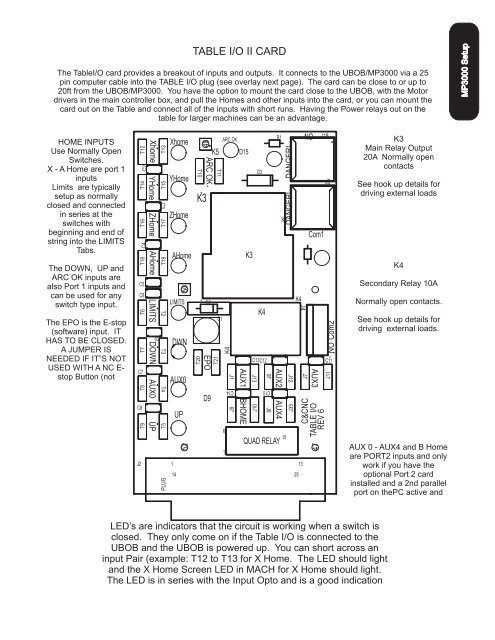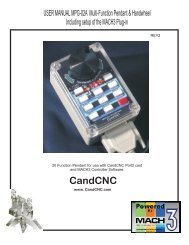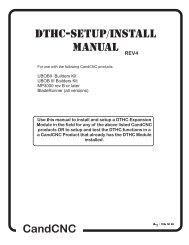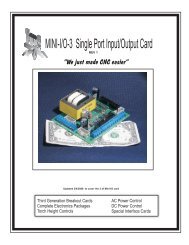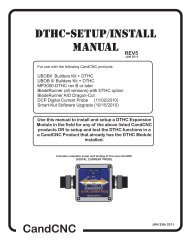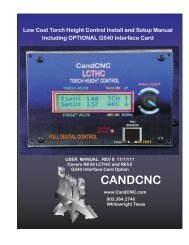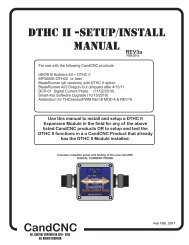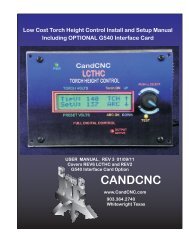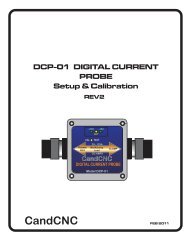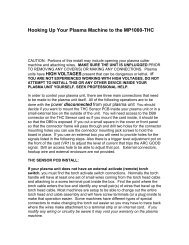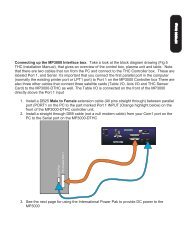Create successful ePaper yourself
Turn your PDF publications into a flip-book with our unique Google optimized e-Paper software.
TABLE I/O II CARD<br />
The TableI/O card provides a breakout of inputs and outputs. It connects to the UBOB/MP3000 via a 25<br />
pin computer cable into the TABLE I/O plug (see overlay next page). The card can be close to or up to<br />
20ft from the UBOB/MP3000. You have the option to mount the card close to the UBOB, with the Motor<br />
drivers in the main controller box, and pull the Homes and other inputs into the card, or you can mount the<br />
card out on the Table and connect all of the inputs with short runs. Having the Power relays out on the<br />
table for larger machines can be an advantage.<br />
MP3000 Setup<br />
HOME INPUTS<br />
Use Normally Open<br />
Switches.<br />
X - A Home are port 1<br />
inputs<br />
Limits are typically<br />
setup as normally<br />
closed and connected<br />
in series at the<br />
switches with<br />
beginning and end of<br />
string into the LIMITS<br />
Tabs.<br />
The DOWN, UP and<br />
ARC OK inputs are<br />
also Port 1 inputs and<br />
can be used for any<br />
switch type input.<br />
The EPO is the E-stop<br />
(software) input. IT<br />
HAS TO BE CLOSED.<br />
A JUMPER IS<br />
NEEDED IF IT”S NOT<br />
USED WITH A NC E-<br />
stop Button (not<br />
T12<br />
C2<br />
T14<br />
T16<br />
C4<br />
T18<br />
C5<br />
C8<br />
T7<br />
T6<br />
C7<br />
T8<br />
C6<br />
T9<br />
Xhome<br />
YHome<br />
ZHome<br />
AHome<br />
LIMITS<br />
C9<br />
DOWN<br />
AUX0 UP<br />
T13<br />
T15<br />
C3<br />
T17<br />
T19<br />
T2 T3 T4<br />
T5<br />
K3<br />
LIMITS D2<br />
K3<br />
NO<br />
Com1<br />
AHome<br />
K3<br />
52<br />
EPO<br />
ARC OK<br />
R1<br />
K5 D15<br />
ARC OK<br />
D9<br />
UP<br />
C1<br />
K4<br />
AUX1<br />
BHOME<br />
D3<br />
K4<br />
AUX2<br />
AUX4<br />
DANGER!<br />
DANGER!<br />
J2<br />
1<br />
13<br />
PLUG<br />
Xhome<br />
YHome<br />
ZHome<br />
50<br />
DWN<br />
AUX0<br />
T20<br />
49<br />
T10<br />
T21<br />
T11<br />
6<br />
1<br />
J1<br />
C14<br />
J9<br />
J10<br />
J6<br />
J8<br />
10<br />
J33<br />
14<br />
25<br />
K4<br />
J4<br />
J7<br />
AUX3<br />
C&CNC<br />
47 TABLE I/O<br />
REV 6<br />
J18<br />
J5<br />
NO Com2<br />
C13C12<br />
C11<br />
J13<br />
C10<br />
QUAD RELAY<br />
J12<br />
J11<br />
K3<br />
Main Relay Output<br />
20A Normally open<br />
contacts<br />
See hook up details for<br />
driving external loads<br />
K4<br />
Secondary Relay 10A<br />
Normally open contacts.<br />
See hook up details for<br />
driving external loads.<br />
AUX 0 - AUX4 and B Home<br />
are PORT2 inputs and only<br />
work if you have the<br />
optional Port 2 card<br />
installed and a 2nd parallel<br />
port on thePC active and<br />
LED’s are indicators that the circuit is working when a switch is<br />
closed. They only come on if the Table I/O is connected to the<br />
UBOB and the UBOB is powered up. You can short across an<br />
input Pair (example: T12 to T13 for X Home. The LED should light<br />
and the X Home Screen LED in MACH for X Home should light.<br />
The LED is in series with the Input Opto and is a good indication


